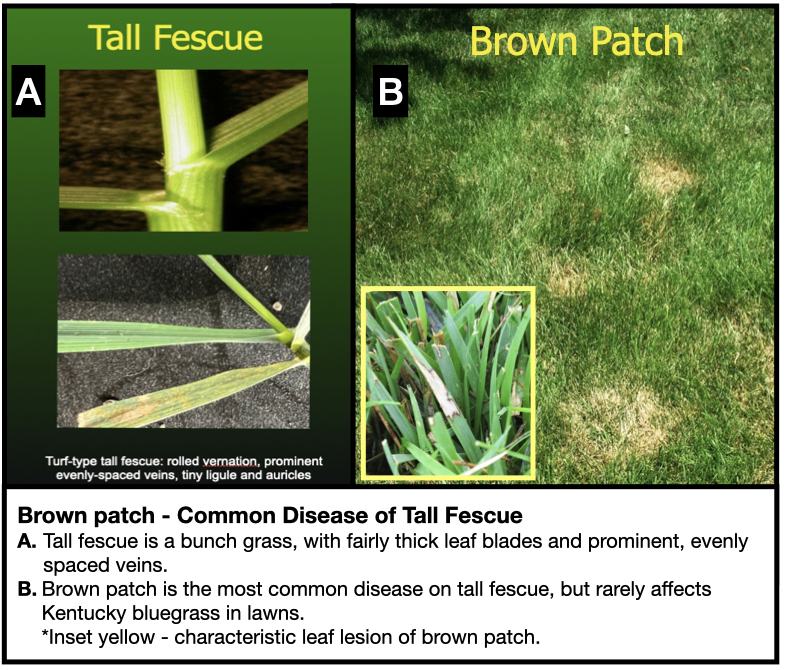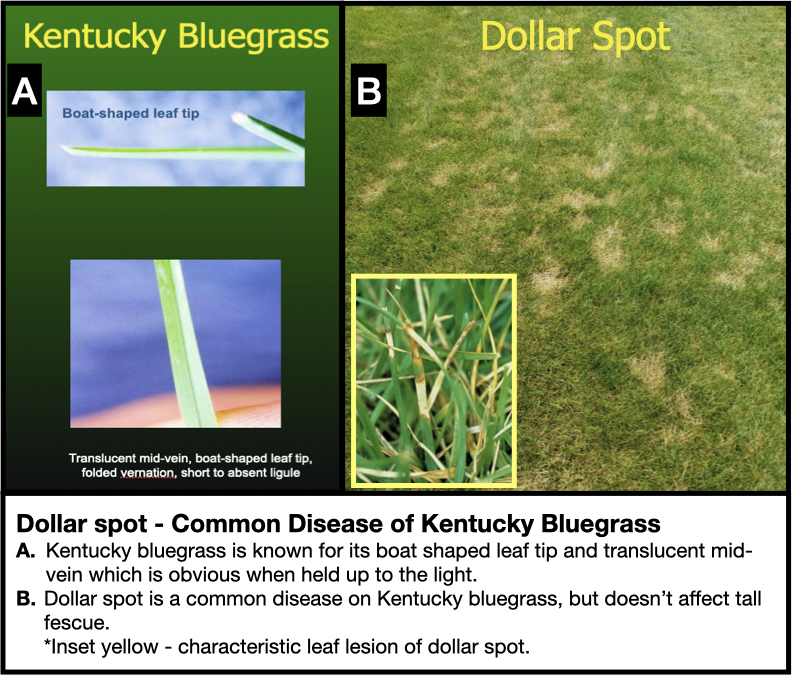As we get into the throngs of summer, disease activity takes hold on the cool season turfgrass species we commonly use on lawns. This spring/early summer 2023 much of the state has been in a considerable drought, missing approximately two inches of normal precipitation in both April and May, and three inches below normal so far this June (see Midwest drought map here). Disease activity has been minimal to non-existent on unirrigated, brown and crunchy lawns, with most damage most likely occurring from unnecessary mowing traffic on non-growing grass. For irrigated lawns, the supplemental water avoids drought dormancy and potential thinning, but also provides the necessary leaf wetness and humidity for diseases to attack.
The two most common diseases on cool season lawns are dollar spot and brown patch. Dollar spot occurs most frequently on Kentucky bluegrass lawns, while brown patch is one of the few diseases that affect tall fescue. Therefore, knowing and being able to identify the grass species that makes up your lawn is an important aspect in caring for it. The first step in any of our lab diagnosis is identifying the plant host, or at least confirming the host listed on the diagnostic form is correct.

The two most common turfgrass species used on lawns in Indiana and much of the region are tall fescue and Kentucky bluegrass. Tall fescue is a bunch type grass, meaning a single plant does not spread and make daughter plants from “runners” (aka stems called rhizomes (underground) or stolons (above ground)). Tall fescue is characterized by relatively thicker leaf blades with prominent, evenly spaced, rough feeling veins running down the leaves. Conversely, Kentucky bluegrass spreads by rhizomes and the leaf is smoother with a single translucent mid-vein that runs down the leaf center. Held up to the sunlight, the translucent mid-vein on Kentucky bluegrass is conspicuous. Kentucky bluegrass also has an infamous boat-shaped leaf tip, whereas tall fescue comes to an abrupt point.

Although somewhat simplistic, knowing if your lawn is predominantly Kentucky bluegrass or tall fescue provides good evidence as to what disease may be affecting it. Leaf symptoms provide additional confirmation of identification and activity of these two diseases. Along the edges of a patch or spot, drive by sweep a handful of leaves. Using a hand lens, look closely at the lesions on the leaf blade. Brown patch is characterized by a dark, irregularly shaped margin with a beige to straw interior. Dollar spot will have a slightly less dark margin, and the lesions often characteristically drive straight across the leaf blade causing an hour-glass shaped lesion.
Control practices for these two diseases are both similar and quite different. For both, leaf wetness is a key driver of the disease epidemic, so reducing early morning shade and limiting irrigation in the early morning hours rather than at dusk can help decrease disease severity. Dollar spot is a low nitrogen disease, so when occurring on Kentucky bluegrass it is an indicator that nitrogen is deficient in the plant and fertilizer should be applied. Brown patch occurrence on tall fescue doesn’t necessarily indicate a nitrogen excessive or deficient state. If a fungicide is warranted, which is rare in most cases, the active ingredients azoxystrobin or pyraclostrobin are most effective against brown patch but have little to no effect on dollar spot. Along with fertility, dollar spot can be suppressed by several other different fungicide chemistries. Last but not least, fall overseeding can often be used to simply fill in the gaps left by these diseases, perhaps with better new improved cultivars. More on this topic in August.
Several other diseases and abiotic disorders can affect the health of lawns, but being familiar with these two common disease criminals can aid in getting the jump on control early. As always, the expertise of the Purdue Plant, Pest and Diagnostic Lab is willing to assist and hopefully reduce the inputs necessary by correctly identifying the problem and appropriate management tactics. For more information, see the many resources available at https://turf.purdue.edu/homeowner-publications/.